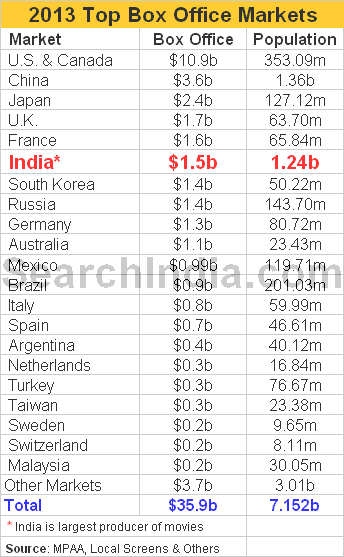
Bizarre Nation
Everything about India is bizarre – Its people, its politicians, its culture and, of course, its movies.
Let’s take the Indian movie business, for instance.
It’s no secret that Indians are insanely crazy about movies. The sight of their favorite star (Rajinikanth, Sharukh Khan, Salman Khan etc) or a fair-skinned item girl jiggling her tits on the screen transports Indian movie fans into an orgasmic frenzy of whistles, dances and shrieks.
It’s also no secret that India makes more movies and in more languages (Hindi, Tamil, Telugu, Malayalam, Marathi, Kannada, Bhojpuri, Punjabi, and Bengali) than any other country on Planet Earth.
Plus, if you take into account the Hollywood releases Indians have the greatest movie choice in the world.
Yet Indian box office returns are pitiful compared to other countries with a far smaller population.
Take a dekko at the above chart and you’ll see some really weird stuff. South Korea with a population just 4% of India’s has nearly the same box office collection as India.
Why Low Indian Box Office Numbers
I do not believe ticket prices are behind the pathetic box office collections in India.
Movie ticket prices have shot through the roof in Indian cities, particularly at the new multiplexes.
In my view, three main reasons account for India’s pathetic box office numbers.
* Rotten Indian Culture: India is populated by two kinds of people – the rotten degenerate corrupt and a slightly less corrupt lot. Indian movie-makers frequently resort to theft and every other dirty trick in the book to churn out movies. And well aware of the rotten behavior of Indian film producers, Indian chutiya movie-viewers (rich or poor) often resort to piracy to see movies be it via Torrent downloads on their laptops or bootleg DVDs on their big screen TVs.
* Poor Quality of Indian Movies: Indians for the most part have no class! Not surprisingly, the overwhelming majority of Indian movies are garbage. Or as SI likes to put it, Indian movies are made by philistines for the sole viewing pleasure of philistines. Unlike Korean or Chinese movies that have an audience far beyond Korea or China and their diaspora, viewership of Indian movies is restricted exclusively to Indians. Talented film-makers and actors like Anurag Kashyap, Irrfan Khan, Naseeruddin Shah, Nawazuddin Siddiqui, Anupam Kher, and Supriya Pathak Kapur do not have many takers for their work. Simultaneously a growing number of Indians (not the diaspora but Indians living in the homeland) are getting disillusioned with the quality of Bollywood movies and turning to European, Korean, Chinese and American films. This obviously has an impact on box office collections in India.
* Movie Fatigue: India also produces far too many movies. Week after week, a slew of movies come out in Hindi, Tamil, Telugu etc. The sheer numbers plus competition from Cricket matches induce fatigue even in avid moviegoers.
No Change Imminent
I do not see any big changes happening in the Indian film industry in the foreseeable future.
Indian box office numbers will continue to remain pathetic.
Piracy will continue at its current rate.
Bollywood and its smaller siblings will continue to churn out the same trash at a frenetic pace.
And more Indians will develop a passion for quality Hollywood, European, Korean and Chinese films that they will obtain by means legal or illegal.

I wonder how these numbers work out per capita.
The high number of movies may not seem so unreasonable then. Of course most of them are horrible and a torture to watch.
May be Indians watch such painful movies to make their real life seem less painful by comparison.
Imagine being mentally tortured for 3 hours and when it’s over everything else seems much more bearable.
SearchIndia.com Responds:
I’d think any way you slice and dice the data, the per capita BO collection figures for India is bound to be low!
India and China have similar population and yet China’s BO collections are more than double ($1.5 billion vs $3.6 billion).
I have no clue about China (though they are geographically placed beside India), but there IS a huge difference in ticket prices.
For example the average ticket price in 2013 works out to approximately $7.50. That’s like around Rs.450.
(http://variety.com/2013/film/news/average-movie-ticket-price-is-highest-ever-1200565675/)
In Mumbai, where I had anchored for a while, only super-premium multiplexes charges that much (on a weekend for a 3D movie that is). Generally it is around Rs.150-250 (BIG/PVR/Inox/Cinemax et al) on weekends. In weekdays it’s even less. And in single screens it’s around Rs.100.
That’s the scenario in Mumbai. Except metropolis and A-grade cities and towns, ticket price seldom exceeds Rs.100.
Conclusion? Ticket price is urban area of India is less than half of price in US and less than one-fourth in town/rural areas. I suppose a fair comparison would be on the number of tickets sold.
SearchIndia.com Responds:
1. I suppose the conversion into $ makes Indian ticket prices and consequently box office collection seem artificially low. Although I disagree that movie ticket prices are low in India when you consider purchasing power of 60% of population. Given U.S. minimum wage of $7.25/hr, it’d take the lowest paid worker slightly more than a hour’s wage to see a movie in any city but it’d take a daily wage India worker several hours to earn the price of a movie ticket in any Indian city.
2. But ticket prices alone wouldn’t explain South Korea (where ticket prices are $8-$9, interest in movies is high like India but population is just 50 million) or China (where population is similar but poverty is declining faster).
3. There’s considerable variation in ticket pricing in the U.S. too. One SI reader mentioned recently that tickets cost just $5 in Oklahoma. Plus matinee shows in other states too can be as low as $5.
4. I agree with you that number of tickets sold would give better insights into the overall Indian movie business.
Although I disagree that movie ticket prices are low in India…
For granted, I am not claiming that ticket prices in India are low. I just wanted to point out that it is lot lesser than when compared to ticket prices in US. So, if 1000 people watch a movie in US and spend $7000 at box office, to amass the same amount in India atleast 3000 people has to watch. Comparing by amount somehow doesn’t makes sense in this regard. It should be more on number of films made against the profits it made at the boxoffice to see the clear picture (10 films making $1 million each is different than one film making $10 million).
Piracy issue is everywhere. In India where honesty is considered as laughing stock, its plenty. Even last week while commuting in train, I saw a well dressed guy holding his 5+ inches(no not that!) Samsung Note, watching the HD print of Queen movie (it got released two weeks back). I suppose Indians somehow lost that feeling called ‘guilt’ in the process of evolution along with many fine qualities.
Well, shouldn’t you take into account the foreign exchange rate?
1 USD is like 61 INR, whereas in Chinese Yuan it’s 6 CY = 1 USD.
Also you should take into account the ticket prices. Even where I live, tickets are $6, which is almost Rs.370 and only high end multiplexes in India sell tickets at this rate.
But at the end of the day, figures for India would still be low I guess. And it deserves to be low.
SearchIndia.com Responds:
1. Even after $ conversion into Rs, it still doesn’t make sense to me because of the huge population (1.2 billion and still breeding at a frenetic pace).
My hypothesis is that maybe not many people are going to the movies in India.
Conventional wisdom is often wrong.
Plus, you can’t trust the hype coming from the movie industry and their media partners.
2. You write: Even where I live, tickets are $6,
Lucky You!
I just paid $11.25 for Arnold Schwarzenegger’s new movie Sabotage!